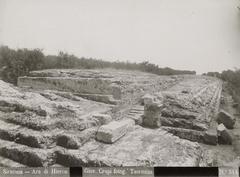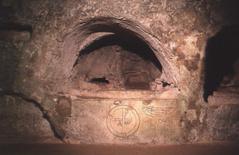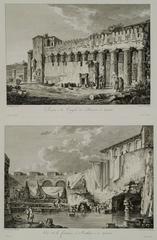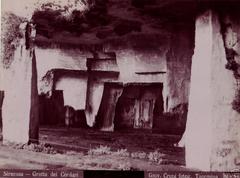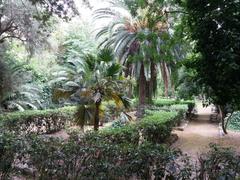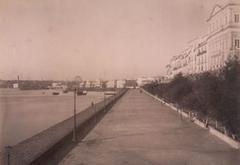
Terme di Dafne Syracuse: Visiting Hours, Tickets, and Historical Site Guide
Date: 04/07/2025
Introduction
Nestled in the heart of Ortigia, the historic center of Syracuse, Sicily, the Terme di Dafne (Baths of Daphne) offer visitors a fascinating glimpse into the city’s ancient urban fabric. Although less famous than the Greek Theatre or Roman Amphitheatre, these late Roman and Byzantine baths are significant for their well-preserved remnants and their connection to pivotal moments in Mediterranean history. Their layered architecture and setting near Porto Piccolo exemplify Syracuse’s ongoing evolution as a crossroads of civilizations (Wikipedia: Terme di Dafne; Lasiciliainrete.it).
This comprehensive guide covers the Terme di Dafne’s history, architecture, cultural relevance, visiting hours, ticketing, accessibility, and travel tips—equipping you to fully appreciate this evocative site and its context within Syracuse’s UNESCO-listed heritage (TravelsHelper.com; Voyage Tips; Academia.edu).
Table of Contents
- Historical Origins and Context
- Construction, Chronology, and Mythological Connections
- The Byzantine Era and Emperor Constans II
- Architectural Features and Archaeological Value
- The Terme di Dafne in Syracuse’s Heritage
- Preservation and Modern Access
- Visiting Information: Hours, Tickets, and Tips
- FAQs
- Recommendations for Visitors
- Conclusion and Further Exploration
- References
Historical Origins and Context
The Terme di Dafne, or Baths of Daphne, are an archaeological complex rooted in the late Roman period, with substantial evidence of later Byzantine refurbishments. Located near the Porto Piccolo and built within a dense urban setting, their history mirrors Syracuse’s broader evolution from a Greek colony (founded in 734 BCE) to a Roman stronghold and then a Byzantine imperial center (Wikipedia: Terme di Dafne; Lasiciliainrete.it). The site’s mythological association with the nymph Daphne reflects the persistence of Hellenic traditions long after the original Greek era.
Construction, Chronology, and Mythological Connections
Archaeological research places the initial construction of the baths in the late Roman era, likely between the 4th and 6th centuries CE. Subsequent modifications—particularly during the Byzantine period—are evidenced by the adaptation of Roman heating systems and the introduction of architectural elements such as domed ceilings and pointed arches (Wikipedia: Terme di Dafne; Lasiciliainrete.it). The scale and location suggest a private or semi-public function, possibly catering to local elites or military personnel.
The name “Dafne” links the site to the mythological nymph Daphne, pursued by Apollo—a motif often associated with water and transformation in Greek art and literature, further underlining the site’s enduring cultural resonance.
The Byzantine Era and Emperor Constans II
A particularly dramatic episode in the history of the Terme di Dafne is its association with the assassination of Emperor Constans II in 668 CE. Byzantine chroniclers record that the emperor was killed while bathing in these very baths during his stay in Syracuse, which at the time was an administrative and strategic hub of the Eastern Roman Empire (Wikipedia: Terme di Dafne; Lasiciliainrete.it). This event underscores both the site’s continued importance in the 7th century and the turbulent political landscape of the era.
Architectural Features and Archaeological Value
Despite being partially concealed beneath modern buildings, the Terme di Dafne retain key features of Roman and Byzantine bath architecture. Visitors can observe remnants of the hypocaust heating systems, mosaic flooring, water channels, and marble cladding (Lasiciliainrete.it). The baths’ integration within the urban fabric—adjacent to the ancient Greek arsenal and the Porto Piccolo—demonstrates the continuous and layered nature of Syracuse’s historical landscape (Mapcarta: Terme di Dafne).
The Terme di Dafne in Syracuse’s Heritage
While the Terme di Dafne may be overshadowed by larger monuments, they are crucial to understanding the everyday life and urban continuity of Syracuse. Their survival underlines the city’s status as a vibrant crossroads of Greek, Roman, and Byzantine cultures. In 2005, Syracuse and the nearby necropolis of Pantalica were recognized as a UNESCO World Heritage Site, with the Terme di Dafne forming part of this rich archaeological tapestry (TravelsHelper.com).
Preservation and Modern Access
Ongoing urban development has left the Terme di Dafne partially embedded under modern structures, complicating both archaeological investigation and public access. Local heritage organizations continue to document, catalog, and promote the site, balancing the need for preservation with that of urban life (Lasiciliainrete.it; Academia.edu). Efforts are also underway to enhance public engagement and improve accessibility.
Visiting Information: Hours, Tickets, and Tips
Location and Access
Terme di Dafne is located in Ortigia’s historic center, within walking distance of Piazza del Duomo and the Temple of Apollo. The entrance can be difficult to spot; advance preparation with a detailed map or GPS is advised (Voyage Tips).
Visiting Hours
- The site is generally accessible by appointment only and is not open for regular public visits due to its integration with private buildings.
- For the latest information, contact the Syracuse archaeological authority or local tourist offices.
Tickets
- Entry is typically managed via guided tours, with prices ranging from €10 to €25 depending on the operator and itinerary.
- Some tours bundle the Terme di Dafne with other archaeological landmarks in Syracuse.
- Occasionally, the site may be open during special events or cultural programs.
Accessibility
- The site is partially accessible; uneven terrain and the historic setting may pose challenges for those with mobility issues.
- Contact tourist offices in advance for the most up-to-date information on accessible routes and facilities.
What to Bring
- Comfortable footwear for walking on cobblestones and uneven ground.
- Water, hat, and sun protection—especially in summer.
- Camera for photography; note that flash photography may be restricted.
- Guidebook or audio guide for context if visiting independently.
Nearby Amenities
- Numerous cafés, restaurants, shops, and restrooms are available in Ortigia within a short walk.
- Accommodation options range from luxury hotels to family-run B&Bs (Get Sicily Hotels).
Frequently Asked Questions (FAQ)
Q: Are there regular opening hours for Terme di Dafne?
A: No, the site is mainly accessible via guided tours or special events. Check with local tourist offices for current availability.
Q: How do I purchase tickets?
A: Tickets are available through tour operators and local tourist offices; advance booking is recommended.
Q: Is the site wheelchair accessible?
A: Accessibility is limited; contact local tourist offices for more details.
Q: Can I visit Terme di Dafne independently?
A: Independent visits are limited. Guided tours are recommended for access and interpretation.
Q: What’s the best time to visit?
A: Early morning or late afternoon, particularly in summer, to avoid heat and crowds.
Recommendations for Visitors
- Join a Guided Tour: Gain deeper insight into the baths’ history and architecture.
- Combine with Other Sites: Integrate your visit with nearby monuments such as the Greek Theatre, Temple of Apollo, and Catacombs of San Giovanni.
- Respect the Site: Do not climb on or remove any part of the ruins.
- Support Conservation: Your ticket and donations help preserve the site for future generations.
Conclusion and Further Exploration
The Terme di Dafne encapsulate the enduring legacy of Syracuse as a center of cultural fusion and urban resilience. Their survival amid a modern cityscape is a testament to the city’s layered history and the ongoing dialogue between past and present. By planning ahead, joining guided tours, and respecting site guidelines, visitors can experience the unique atmosphere of these ancient baths and deepen their understanding of Mediterranean civilizations.
For more information, download the Audiala app for audio guides and real-time updates, explore related articles on Syracuse’s historical sites, and follow our channels for the latest news and special events.
References
- Wikipedia: Terme di Dafne
- Lasiciliainrete.it
- TravelsHelper.com
- Voyage Tips
- Academia.edu
- Mapcarta: Terme di Dafne
- Get Sicily Hotels
Explore the Terme di Dafne and immerse yourself in the rich heritage of Syracuse—where ancient traditions meet vibrant modern life.


